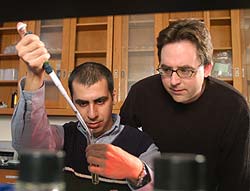Life Sciences and Chemistry
Articles and reports from the Life Sciences and chemistry area deal with applied and basic research into modern biology, chemistry and human medicine.
Valuable information can be found on a range of life sciences fields including bacteriology, biochemistry, bionics, bioinformatics, biophysics, biotechnology, genetics, geobotany, human biology, marine biology, microbiology, molecular biology, cellular biology, zoology, bioinorganic chemistry, microchemistry and environmental chemistry.

Two brain systems tell us to breathe
Until now, scientists believed that a single area in the brain generated breathing rhythm, enabling breathing to speed up or slow down to adapt to the body’s activity and position. But UCLA neurobiologists have discovered that two systems in the brain interact to generate breathing rhythm — a finding that may translate into better treatment for sleep apnea and sudden infant death syndrome. The journal Neuron reported the findings in its March 6 issue.
“We originally thought that only one bra

Myosin V, The Molecular Motor, Moves in ’Monkey-Bar’ Motion
Unique Hand-Over-Hand Rotation Transports Molecules Through Cells
Within every neuron is a vast protein trail system traversed by a small protein engine called Myosin V. The long-standing question of how this molecule moves may have finally been resolved by researchers from the University of Pennsylvania School of Medicine. Their findings, presented in this week’s issue of Nature, show how myosin V can move ’hand-over-hand’ on tracks, composed of a protein called actin,

Laser micro-scalpel yields biological insights into tissue dynamics
Using a laser beam scalpel so fine it could inscribe words on the surface of a fly egg, researchers have snipped their way to a new understanding of a key process in a fruit fly’s embryonic development. The process, called dorsal closure, is the complex mechanism by which the embryonic skin of the fruit fly Drosophila knits itself together to protect its innards from the outside world.
Understanding this seemingly arcane process is important because dorsal closure uses molecular and cellular

Sometimes no result is good result for science
Sometimes finding out what doesn’t matter in science is just as important as finding what does.
That’s the case for a study that looked at the function of the viral protein, MTase1. Researchers found that the rate of virus replication in tissue culture was not affected when MTase1 was removed.
The finding is important as researchers look for what proteins are essential and how they function in cells, potentially providing answers to everything from insect control to the co

Protein engineering produces ’molecular switch’
Technique could lead to new drug delivery systems, biological warfare sensors
Using a lab technique called domain insertion, Johns Hopkins researchers have joined two proteins in a way that creates a molecular “switch.” The result, the researchers say, is a microscopic protein partnership in which one member controls the activity of the other. Similarly coupled proteins may someday be used to produce specialized molecules that deliver lethal drugs only to cancerous cells. They also m

UCSD researchers develop flexible, biocompatible polymers with optical properties of hard crystalline sensors
Researchers at the University of California, San Diego have discovered how to transfer the optical properties of silicon crystal sensors to plastic, an achievement that could lead to the development of flexible, implantable devices capable of monitoring the delivery of drugs within the body, the strains on a weak joint or even the healing of a suture.
The discovery is detailed in the March 28 issue of Science by a UCSD team that pioneered the development of a number of novel optical sensor